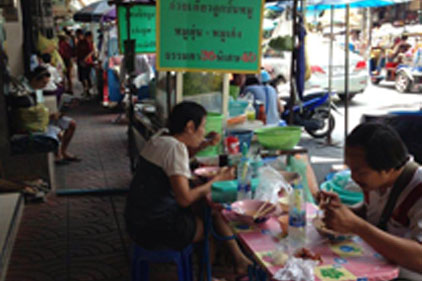 I started writing this month’s viewpoint in May, on the plane coming back from my second visit to Thailand.
I started writing this month’s viewpoint in May, on the plane coming back from my second visit to Thailand.
I was there as a guest of the Thai Ministry of Commerce and its Department of Inter-national Trade Promotion. The purpose was to attend the Thai Rice Conference and Exhibition in Chiang Mai and also visit the annual ThaiFex 2013 World of Food international trade show in Bangkok.
Thai cuisine has been a favorite since my hometown, Dallas, got its first Thai restaurant in the early 1980s. I could eat Thai foods every day. Interestingly enough, some of the best Thai dishes I’ve ever eaten were in the U.S., at Thai Flavors, a little restaurant in Des Moines, Iowa. It is top-notch eats, and more than equal to the very best I’ve ever had in Thailand.
On the return flight from Thailand, I wondered why that is, and why so many other ethnic cuisines don’t always fully translate to these shores.
At 35,000 feet up, the answer hit me: authenticity. The thing that makes the food at Thai Flavors so outstanding is the use of ingredients that, while difficult to get, are exactly those you get in Thailand—kaffir limes, galangal, long peppers, lemongrass, tiny green Thai eggplants and a myriad of spices, cabbages and root vegetables with names guaranteed to bend the tongue and excite the palate.
After Liam Anivat, Thai Flavors’ owner, moved to Des Moines some 15 years ago, he was disappointed at the lack of authentic food from his homeland. Rather than make do with what was available (as do too many makers of ethnic cuisines), he went out of his way to get the real ingredients he needed. Sometimes that meant bringing them 350 miles from Chicago or having them sent directly from Thailand. It literally paid off. Liam now has two restaurants in Des Moines, both usually packed.
This drive for authenticity is a lesson processors have learned well. There can be no compromise when it comes to ingredients. In today’s well-traveled world, too many Americans know what real, authentic Asian cuisines —Thai, Vietnamese, or Korean or regional Chinese, etc.—truly taste like. Substitute plain lime for kaffir lime, and you’re busted; use lemon instead of lemongrass, and your formulation is forgettable. Galangal? Good luck faking that unique flavor. Nearly always, it just gets omitted from the recipe.
Our feature story, “Authentic Asian,” by the globe-trotting guru of Southeast Asian cuisine, chef Robert Danhi, explores this authenticity, focusing on some key ingredients and techniques used in creating true Asian creations. And, for more about my visit to ThaiFex 2013 and the Thai Rice Conference, check out the stories and slide shows I’ve posted on www.preparedfoods.com.
Save the Date: March 4-6, 2014
The Latin American Food Congress, now in its second year, will be held March 4-6, 2014, at Westin Santa Fe in Mexico City, Mexico.
The Latin American Food Congress is Latin America’s premier educational conference providing product development and manufacturing solutions for the Food & Beverage Industry. Educational sessions focus on Formulation and R&D Challenges, Food Safety, Manufacturing Proficiencies and Plant Modernization Solutions. LAFC offers attendees a unique opportunity to network with industry experts, while learning how to improve business practices, efficiencies and develop new products.
Join hundreds of Latin American food and beverage industry owners, presidents, vice presidents, and directors and leaders of operations, R&D, sales and marketing at the 2nd Annual Latin American Food Congress. For complete information, please visit www.latinamericanfoodcongress.com.
For sponsorship opportunities or any questions, please contact Marge Whalen at 847-405-4071 or whalenm@bnpmedia.com.

